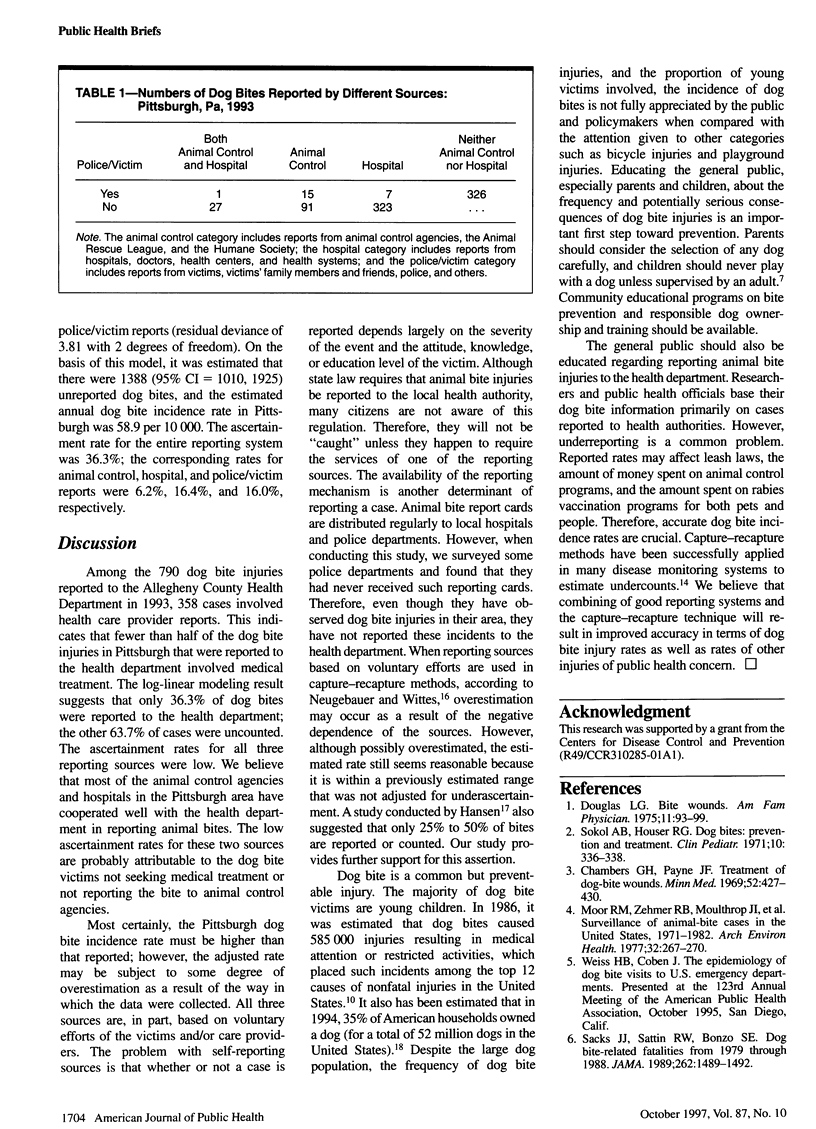Abstract
OBJECTIVES: The purpose of this study was to estimate the number of dog bite injuries occurring in the city of Pittsburgh in 1993. METHODS: The capture-recapture method was used, along with long-linear modeling. Three sources were used to identify victims hospital reports, animal control reports, and police/victim reports. RESULTS: In 1993, 790 dog bites were reported. The capture-recapture method estimated that there were 1388 unreported dog bites, with an estimated incidence rate of 58.9 per 10,000. CONCLUSIONS: Dog bite is a common our preventable injury. To improve surveillance, the focus should be on educating the general public about the serious consequences of dog bite injuries.
Full text
PDF


Selected References
These references are in PubMed. This may not be the complete list of references from this article.
- Beck A. M., Loring H., Lockwood R. The ecology of dog bite injury in St. Louis, Missouri. Public Health Rep. 1975 May-Jun;90(3):262–267. [PMC free article] [PubMed] [Google Scholar]
- Chambers G. H., Payne J. F. Treatment of dog-bite wounds. Minn Med. 1969 Mar;52(3):427–430. [PubMed] [Google Scholar]
- Douglas L. G. Bite wounds. Am Fam Physician. 1975 Apr;11(4):93–99. [PubMed] [Google Scholar]
- Langley J. The incidence of dog bites in New Zealand. N Z Med J. 1992 Feb 12;105(927):33–35. [PubMed] [Google Scholar]
- Moore R. M., Jr, Zehmer R. B., Moulthrop J. I., Parker R. L. Surveillance of animal-bite cases in the United States, 1971-1972. Arch Environ Health. 1977 Nov-Dec;32(6):267–270. doi: 10.1080/00039896.1977.10667293. [DOI] [PubMed] [Google Scholar]
- Neugebauer R., Wittes J. Voluntary and involuntary capture-recapture samples--problems in the estimation of hidden and elusive populations. Am J Public Health. 1994 Jul;84(7):1068–1069. doi: 10.2105/ajph.84.7.1068. [DOI] [PMC free article] [PubMed] [Google Scholar]
- Regal R. R., Hook E. B. Goodness-of-fit based confidence intervals for estimates of the size of a closed population. Stat Med. 1984 Jul-Sep;3(3):287–291. doi: 10.1002/sim.4780030310. [DOI] [PubMed] [Google Scholar]
- Sacks J. J., Lockwood R., Hornreich J., Sattin R. W. Fatal dog attacks, 1989-1994. Pediatrics. 1996 Jun;97(6 Pt 1):891–895. [PubMed] [Google Scholar]
- Sacks J. J., Sattin R. W., Bonzo S. E. Dog bite-related fatalities from 1979 through 1988. JAMA. 1989 Sep 15;262(11):1489–1492. doi: 10.1001/jama.262.11.1489. [DOI] [PubMed] [Google Scholar]
- Sokol A. B., Houser R. G. Dog bites: prevention and treatment. Comments from the surgeon's viewpoint. Clin Pediatr (Phila) 1971 Jun;10(6):336–338. doi: 10.1177/000992287101000616. [DOI] [PubMed] [Google Scholar]
- Sosin D. M., Sacks J. J., Sattin R. W. Causes of nonfatal injuries in the United States, 1986. Accid Anal Prev. 1992 Dec;24(6):685–687. doi: 10.1016/0001-4575(92)90022-b. [DOI] [PubMed] [Google Scholar]
- Wise J. K., Yang J. J. Dog and cat ownership, 1991-1998. J Am Vet Med Assoc. 1994 Apr 15;204(8):1166–1167. [PubMed] [Google Scholar]
- Wright J. C. Severe attacks by dogs: characteristics of the dogs, the victims, and the attack settings. Public Health Rep. 1985 Jan-Feb;100(1):55–61. [PMC free article] [PubMed] [Google Scholar]


